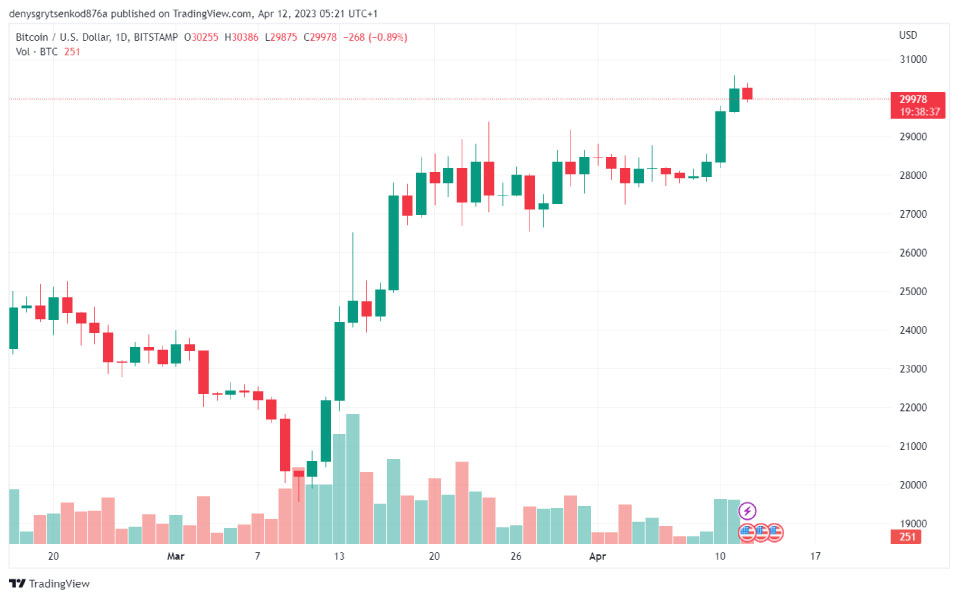The exchange rate of Bitcoin surpassed $30 thousand on the morning of April 11, marking its first such high since June 1, 2022. The cryptocurrency’s value increased by 7% as it grew in price by $2 thousand over the course of the day.
Altcoins also saw an upward trend, although not as significant as that of Bitcoin. Ethereum (ETH) rose to $1.91 thousand, representing a 3.5% increase in value. BNB (BNB) and Polygon (MATIC) also saw increases of 4.6% ($327) and 3.2% ($1.13), respectively. Cardano (ADA) grew by 4.7% to $0.4, while Ripple (XRP) rose 2.7% to $0.51.
Bitcoin has reached a significant milestone by breaking through the $30,000 level for the first time in 10 months. The driving force behind this rise in value was investor confidence in the US Federal Reserve System’s plan to end its tough monetary policy phase. The BTC surge could have occurred earlier, but the majority of investors were absent from trading during Good Friday and Easter in the Catholic world.
On Monday, as traders returned to work, they responded naturally to the Friday employment market statistics from the US by raising prices. The NFP employment data suggested that employers were feeling confident and keeping hiring rates high.
Since the start of April, BTC’s rate has grown by 6.74% compared to a 23% increase in March. The primary objective now is to maintain a foothold above $30,000, with the next ambitious goal being $35,000, which may take time to achieve.
Now you have to buy for $30,000?
Bitcoin broke free from a long period of consolidation between $27,000 and $28.5 thousand, gathering momentum to overcome the resistance level in the $28.5 thousand area. Riding a wave of bullish sentiment, it finally reached the long-awaited milestone of $30,000.
It’s difficult to predict whether a correction will occur since the market is anticipating the release of data on the growth of consumer prices in the US (CPI) on April 12. This index always affects the situation in the cryptocurrency market. It’s important to understand that it can either push the bitcoin rate higher or bring it down.
Continued high inflation could have both effects, meaning that if inflation remains high and fails to meet expectations for a decrease, then the bitcoin rate may respond with a short-term decline or growth.In the long run, continued high inflation is expected to fuel Bitcoin’s growth, as many investors view BTC as a means of hedging against inflationary risks.
The looming collapse of the banking system, which has yet to fully manifest, is also contributing to the rise of the bitcoin rate. Retail investors, in a panic, are searching for safe-haven assets to preserve value and avoid a repeat of the 2008-2009 crisis. As a result, some of the deposits withdrawn from American banks are finding their way into the crypto market.
Addressing the potential query about whether investors will have a chance to purchase bitcoin at $15,000, it’s worth noting that the cryptocurrency was traded between $15,000 and $25,000 for 275 days, giving investors almost a year to decide on buying the asset. If they didn’t, they would now have to purchase bitcoin at $30,000. In the short to medium term, it’s unlikely that the BTC price will dip below $20,000.
Impact of inflation data on directional change
The bitcoin market has been stagnant for a while, gathering strength for a breakthrough towards the $30,000 level, which has been achieved. This breakthrough could be attributed to a number of factors.
Firstly, the US inflation rate for March is about to be announced. If there is a decrease in the inflation rate, it could have a positive impact on the stock market, which, in turn, may lead to an increase in the value of Bitcoin. A reduction in inflation rates could imply the Federal Reserve may ease monetary policy, which could potentially drive up the indices and cryptocurrencies.
Secondly, given the predictions of a global recession, more investors are turning to crypto as a means of safeguarding their funds. This influx of capital into the cryptocurrency market is likely to drive up Bitcoin’s price.
However, it all depends on the inflation data – a decline could potentially increase the price to $32,000-$34,000, whereas an increase may result in a rollback to $27,000-$28,000. These trends are expected to become more pronounced towards the end of the week.




